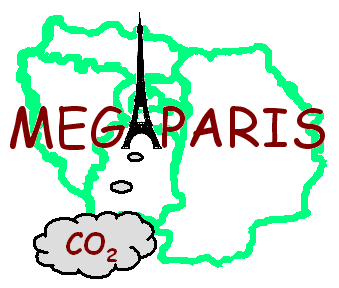

Inferring daily to monthly CO2 fluxes up to the 2x2 km2 scale from inverse modeling requires skilled
regional modeling tools and boundary conditions. Such tools are already implemented at CNRM and LSCE,
which benefit from large and experienced teams in the the domain.
Furthrmore, the CNRM/GAME team has developped a high expertise and strong skills in urban meteorology
modelling [Masson, 2006 ; Masson et al., 2002]. The modeling framework will be made of five
components:
1-The Eulerian model: AROME (resolution: 2.5 x 2.5 km2, hourly)
The AROME model is a mesoscale numerical weather prediction system developed and used
operationally at MeteoFrance over the domain of mainland France at a resolution of 2.5 km. Its research
antecedent (MESONH) has already been shown to simulate very well the mesoscale distribution of CO2 [Sarrat
et al., 2006, 2008]. Furthermore, AROME contains a module that enables the transport of passive tracers.
2-A Lagrangian model: LPDM
We will use the Lagrangian Particle Dispersion Model (LPDM) [Uliasz, 1994] forced with AROME
meteorology. The model was previously used in high-resolution CO2 inverse studies by [Lauvaux et al.,
2008a,b,c]. A similar coupling between Méso-NH and LPDM has also been developed for accidental release
and is used operationally in the context of national emergencies [Lac et al., 2008].
3-An Eulerian transport model: WRF/CHIMERE (resolution: up to 2x2 km2, hourly)
The Weather Research and Forecasting (WRF) model is a mesoscale numerical weather prediction
system suitable for simulation down to a few kilometres resolution. It is non-hydrostatic and uses terrain
following vertical coordinates. It will be used at LSCE nudged to ECMWF winds.
CHIMERE is a multi-scale chemical transport model. It has been recently benchmarked for CO2
simulations in [Patra et al., 2008 ; Law et al., 2008]. It uses the meteorology from WRF.
4-An Inversion tool: 4Dvar
A variational data assimilation system for optimally estimating fluxes given prior information from inventories
and a series of atmospheric observations. The system in place at LSCE [Chevallier et al., 2005] is optimised for
the flux inversion problem up to a resolution as high as 2x2 km2 on a hourly time step.
5- Modelling boundary conditions:
>> CO2 anthropogenic emissions from the CITEPA associations, who will provide CO2 hourly emissions
with a spatial resolution of 1x1km2 from the Paris agglomeration and monthly inventories for other regions with
a similar spatial resolution scheduled for the first semester 2009. Note that once again, these inventories, while
very useful to initialize the mesoscale model, have not yet been verified by any other method: this is one of our
main objectives, by comparing the final CO2 fluxes coming out of this proposal to the inventories.
>> CO2 biospheric fluxes from the vegetation/crop model ORCHIDEE/STICS. Among the existing
biospheric models, ORCHIDEE/STICS (developed at IPSL) is one of the best performed vegetation models
worldwide. It has been tested successfully on forest and crop sites [Gervois et al., 2004]. Since Ile-de-France
grounds are mainly covered by crops (53%) and forests (23%) [De Biasi et et Stephan, 2004], this model should
be well suited for our project, offering an hourly resolution up to 8x8 km2.